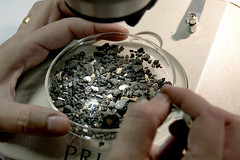Environmental sampling is essential for the recovery of small plant and faunal remains such as cereal grain, chaff, insects, molluscs and small bones. The study of these remains can provide vital information on factors such as economy, agriculture, diet, trade and the environment of past settlements.
The environmental processing has been ongoing throughout the excavations on the East Kent Access Road. Generally samples are taken from features which are thought to have a high potential for environmental remains, and are then brought back to the compound for us to process. The standard size for a sample taken for charred remains is 40 litres. The samples are floated in a modified flotation tank, which allows any preserved plant remains and molluscs to float and be collected on a fine mesh, known as the flot. The remaining residue is sieved through graded meshes. The flot is then allowed to dry and scanned under a binocular microscope in order to determine the presence and preservation of charred plant remains. The dried residues are scanned by eye, with any surviving bones or artefacts retained.
The samples we have processed from this site have been very varied and have displayed a good range of material and will eventually, when fully analysed, be able to provide a good environmental reconstruction of the site. The preserved plant remains from the samples have all been charred (with the exception of a few mineralised examples) and will be able to provide information on land use, agriculture, trade and economy. The mollusc preservation has been varied, with the sites on the calcareous zones providing a much larger assemblage of well preserved molluscs than those sites on brick earth or Thanet Sands. Because molluscs are very indicative of the environments in which they live, the analysis of these assemblages will help us to build up a picture of environment and landscape change through the different periods of the site.
Environmental processing can often be a very wet and muddy job! It can also be very varied, with one sample containing the burnt remains of a disused hearth, and the next sample containing a layer (complete with poo!) from a Roman cess pit. Processing the samples on site has its advantages, as we can swiftly identify the features which are providing productive remains, and target them for future sampling. Processing and analysis of the samples will continue for some time after the excavation has finished.
Laura Stafford






Place your comment